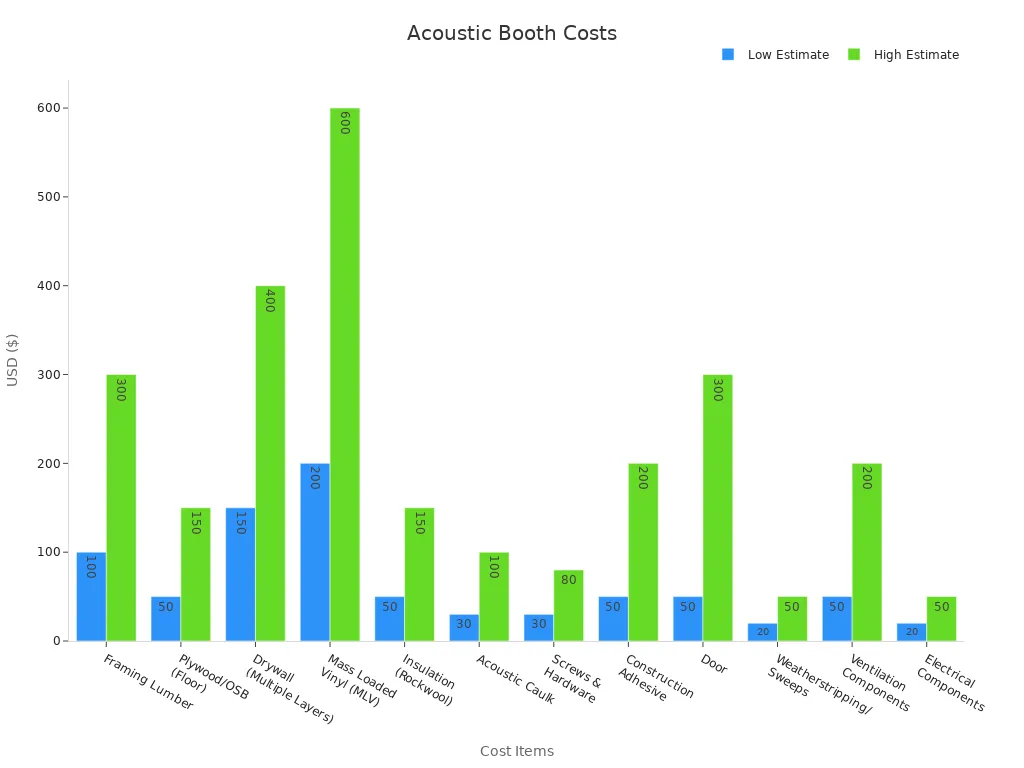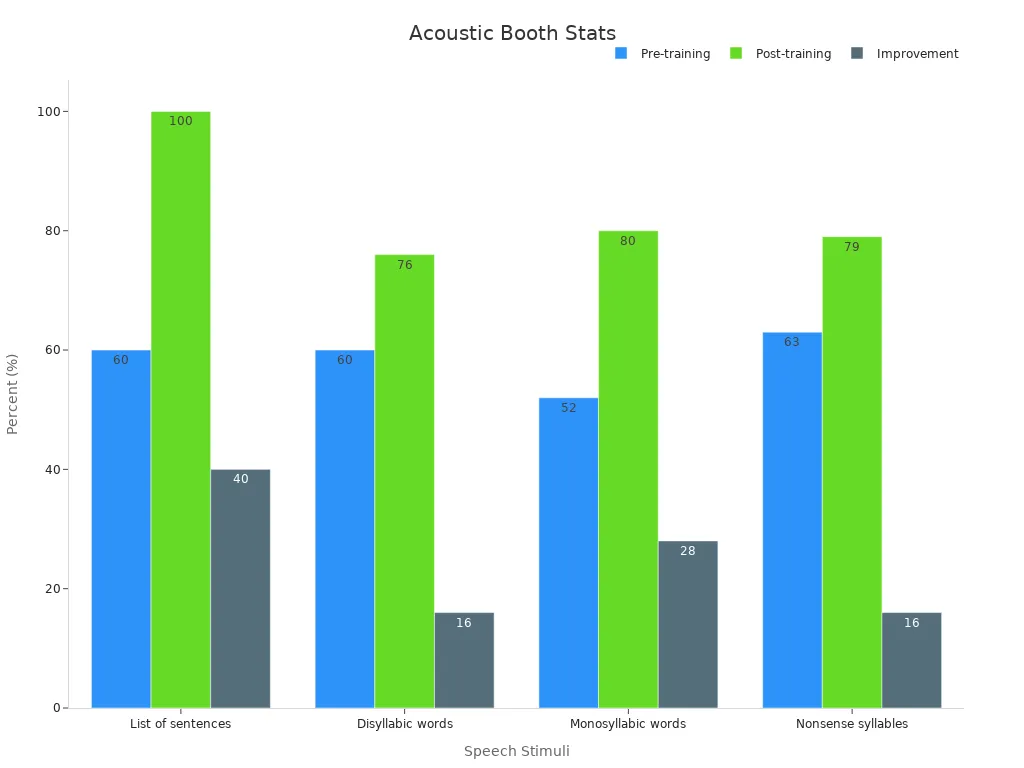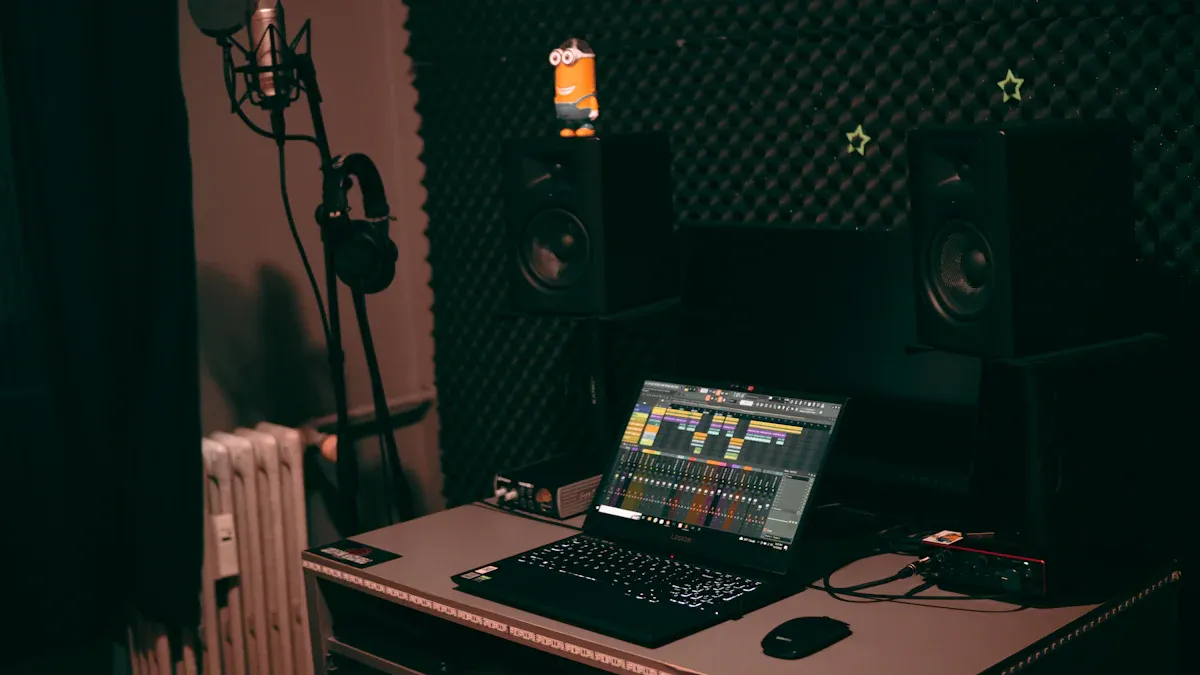
Portable and modular acoustic sound booth options often attract beginners with their easy setup and flexible use. Entry-level commercial booths and well-planned DIY builds provide strong sound isolation without high costs. The following chart shows how building a booth can fit a range of budgets:

People who use Office Work Pods, a soundproof phone box, or a modular office phone booth often find assembly simple and results effective.
Acoustic Sound Booth Basics
What Is an Acoustic Sound Booth
An acoustic sound booth is a specialized enclosure designed to control sound within a defined space. These booths help reduce unwanted noise and manage sound reflections, creating an environment suitable for recording, practicing, or auditory training. Several technical concepts define the basics of these booths:
- Critical Distance (Dc) marks the point where direct sound and reflected sound become equal in level.
- Effective booths balance absorption and diffusion. Absorption, especially for bass, reduces echoes, while diffusion scatters sound for a natural feel.
- Geometric features like angled panels and diffusors guide sound waves and improve clarity.
- The diffuse field should be about 27 dB lower than the direct sound near the source.
- Room size and shape affect performance. A room that is too dead can hinder musicians’ ability to hear themselves.
- Acoustic foam and diffusors enhance sound quality but do not provide full soundproofing. True isolation depends on dense materials and air gaps.
Tip: Treat the front walls and ceiling near the main listening area with absorption. Use a mix of diffusion and absorption on other surfaces for balanced sound.
Main Uses for Beginners
Beginners use acoustic sound booths for a range of activities. These include voice recording, music practice, podcasting, and auditory training. Many cochlear implant users benefit from these booths during auditory recognition exercises. Studies show that training in a sound-attenuated booth at 70 dB can boost sentence recognition from 60% to 100%. Other speech tasks, such as recognizing disyllabic and monosyllabic words, also show marked improvement.
| Speech Stimuli | Pre-training (%) | Post-training (%) | Improvement (%) |
|---|---|---|---|
| List of sentences | 60 | 100 | 40 |
| Disyllabic words | 60 | 76 | 16 |
| Monosyllabic words | 52 | 80 | 28 |
| Nonsense syllables | 63 | 79 | 16 |

These results highlight the booth’s value for beginners seeking a controlled and effective sound environment.
Key Features of an Acoustic Sound Booth for Beginners

Sound Isolation and Acoustic Treatment
Sound isolation stands as the most important feature for any acoustic sound booth. Beginners need a booth that blocks outside noise and prevents sound from leaking out. Acoustic treatment, such as foam panels and bass traps, helps control echoes and improves recording quality. Many entry-level booths use layered walls and dense materials to achieve this effect.
Size and Space Considerations
Choosing the right size ensures comfort and practicality. A booth that is too small can feel cramped, while a large booth may not fit in a home or office. Beginners should measure their available space before selecting a model. A simple table can help compare common booth sizes:
| Booth Type | Typical Size (ft) | Best For |
|---|---|---|
| Portable | 3 x 3 | Solo recording |
| Modular | 4 x 4 to 6 x 6 | Small groups |
Ventilation and Comfort
Proper ventilation keeps the booth comfortable during long sessions. Many booths include built-in fans or vents. Good airflow prevents overheating and maintains fresh air.
Lighting and Accessibility
Adequate lighting allows users to see scripts, instruments, or equipment. Easy-to-open doors and wide entryways improve accessibility for all users.
Ease of Setup
Beginners benefit from booths that assemble quickly. Modular and portable designs often require only basic tools. Clear instructions save time and reduce frustration.
Budget and Cost Factors
Cost remains a key concern for beginners. Many start with affordable options that offer essential features. Comparing prices and features helps users find the best value in an acoustic sound booth.
Types of Acoustic Sound Booths for Beginners

Portable Acoustic Sound Booths
Portable acoustic sound booths offer flexibility and convenience. Many beginners choose these booths because they can move them easily from one location to another. These booths often come in lightweight designs and foldable structures. Users can set them up quickly in bedrooms, offices, or even shared spaces.
Key Benefits:
- Easy to transport and store
- Quick assembly and disassembly
- Suitable for temporary or multi-use environments
Tip: Portable booths work well for podcasters, voice-over artists, and musicians who need a quiet space on demand.
Some models include built-in acoustic panels and ventilation. Others allow users to add their own sound-absorbing materials. Most portable booths fit one person and basic recording equipment.
Modular Acoustic Sound Booths
Modular acoustic sound booths provide a balance between permanence and flexibility. These booths use prefabricated panels that connect together, allowing users to customize the size and shape. Many beginners appreciate modular booths because they can expand or reconfigure them as their needs change.
Features of Modular Booths:
- Customizable layouts
- Sturdy construction
- Easy to upgrade or relocate
| Feature | Benefit |
|---|---|
| Modular panels | Flexible sizing |
| Tool-free assembly | Simple setup |
| Expandable design | Grows with user’s requirements |
Ningbo Cheerme Intelligent Furniture Co., Ltd. stands out as a professional manufacturer in this field. The company designs and produces modular office cabins that support digital rapid assembly. Their products help users save costs and support sustainability goals.
DIY Acoustic Sound Booths
DIY acoustic sound booths attract beginners who enjoy hands-on projects. Building a booth from scratch or using a kit can save money and allow for full customization. Many people use common materials like PVC pipes, moving blankets, and acoustic foam.
Steps for a Simple DIY Booth:
- Measure the available space.
- Build a frame using wood or PVC.
- Attach sound-absorbing materials.
- Add a door or curtain for entry.
Note: DIY booths require careful planning to achieve good sound isolation. Beginners should research materials and follow guides for best results.
DIY options work well for those with basic tools and a willingness to experiment. Many online communities share tips and blueprints for building effective booths at home.
Entry-Level Commercial Acoustic Sound Booths
Entry-level commercial acoustic sound booths provide a ready-made solution for beginners. Manufacturers design these booths for easy installation and reliable performance. Most models include soundproof walls, ventilation, and built-in lighting.
Advantages:
- Professional appearance
- Consistent sound isolation
- Minimal setup required
These booths often come in standard sizes and ship with clear instructions. Many users find them ideal for home studios, offices, or educational settings. Entry-level commercial booths offer a strong starting point for anyone who wants a dedicated recording space without building from scratch.
How to Choose the Right Acoustic Sound Booth
Assessing Your Needs and Goals
Every beginner should start by identifying their main purpose for the booth. Some need a quiet space for voice recording, while others want a booth for music practice or online meetings. Personal comfort and acoustic preferences matter. Physiological and psychological factors, such as how a person feels in different sound environments, play a role. An adaptive acoustic comfort framework helps match booth features to individual needs by considering both personal and environmental factors.
Measuring Your Space
Accurate measurements prevent future problems. Measure the length, width, and height of the available area. Leave enough room for doors to open and for ventilation. A table can help organize these details:
| Area to Measure | Minimum Space Needed |
|---|---|
| Floor Space | 3 x 3 ft |
| Ceiling Height | 7 ft |
| Door Clearance | 2 ft |
Setting a Realistic Budget
Set a budget before shopping. Entry-level booths and DIY kits cost less, while modular and commercial booths may require a higher investment. Consider both the initial price and any extra costs for accessories or upgrades.
Comparing Features and User Reviews
Compare features like sound isolation, ventilation, and lighting. User reviews often reveal real-world performance. Look for feedback on setup, comfort, and durability. Simulation-based modeling tools, such as COMSOL Multiphysics, help predict how a booth will perform in different settings.
Planning for Future Upgrades
Choose a booth that can adapt as needs change. Modular designs allow for easy expansion. Planning ahead saves money and effort in the long run.
Tip: Think about future equipment or new uses before making a final choice.
Common Mistakes Beginners Make with Acoustic Sound Booths
Overlooking Ventilation and Comfort
Many beginners focus on sound isolation and forget about ventilation. A booth without proper airflow can become hot and stuffy. Users may feel uncomfortable during long sessions. Good ventilation keeps the air fresh and helps maintain focus. Some booths include built-in fans or vents. Others allow users to add small, quiet fans.
Tip: Always check for ventilation options before buying or building a booth. Comfort leads to better performance.
Ignoring Size Limitations
Some people choose a booth that does not fit their space. A booth that is too large may not fit in a room. A booth that is too small can feel cramped and limit movement. Beginners should measure their available space and compare it to the booth’s dimensions.
| Booth Size | Best Use | Room Needed |
|---|---|---|
| 3×3 ft | Solo recording | Small room |
| 4×4 ft | Small group | Medium room |
Underestimating Setup Complexity
Setting up a booth can take more time and effort than expected. Some modular or DIY booths require tools and careful assembly. Beginners may skip reading instructions or miss important steps. This can lead to poor sound isolation or unstable structures.
Note: Read the manual and follow each step. Ask for help if needed.
Focusing Only on Price
Price matters, but it should not be the only factor. Some low-cost booths lack key features like sound isolation or comfort. Beginners should compare features, user reviews, and long-term value. Investing in quality saves time and frustration later.
- Look for booths with good reviews.
- Check for essential features.
- Balance cost with performance.
Recommended Acoustic Sound Booths for Beginners
Top Portable Acoustic Sound Booth Models
Portable booths offer flexibility for users who need a quiet space in different locations. Many experts recommend models like the QuietSpace 3000 and FocusBox Pro. These booths provide strong noise reduction, active ventilation, and adjustable lighting. Users can set them up quickly in home offices or shared workspaces. The following table compares key features:
| Model | Noise Reduction | Capacity | Ventilation | Price Range |
|---|---|---|---|---|
| QuietSpace 3000 | 42 dB | 1 person | Active system | $2,500 – $3,000 |
| FocusBox Pro | 40 dB | 1 person | Active system | $3,200 – $3,800 |
These models suit solo recording, remote work, and calls.
Best Modular Acoustic Sound Booth Options
Modular booths, such as the OfficeZen Pod, allow users to expand or reconfigure their space. This type of acoustic sound booth supports team meetings and small group work. OfficeZen Pod stands out for its spacious design, superior noise isolation, and integrated standing desk. Users benefit from active ventilation and adjustable lighting.
Modular booths provide flexibility for growing needs and easy relocation.
Popular DIY Acoustic Sound Booth Kits
DIY kits attract budget-conscious users who want full customization. Many people use materials like acoustic panels, bass traps, and diffusers to build their own booths. These solutions cost less but require time and effort. DIY booths often lack professional aesthetics but allow users to tailor the space to their needs.
- Lower cost with budget materials
- Customizable design
- Time-intensive assembly
Affordable Entry-Level Commercial Acoustic Sound Booths
Entry-level commercial booths deliver professional results with minimal setup. Models like QuietSpace 3000 and FocusBox Pro come ready to use, featuring integrated lighting and ventilation. These booths offer consistent sound isolation and suit home studios, offices, or classrooms. Maintenance costs remain low, and installation takes only a few hours.
Entry-level commercial booths combine convenience and performance for beginners.
Portable and modular booths give beginners a smart starting point. These options balance price, performance, and ease of use. Focus on sound isolation, comfort, and size. Start with a simple setup. Upgrades remain possible as needs change. Take the first step and enjoy a dedicated workspace.
FAQ
What is the easiest acoustic sound booth for beginners to set up?
Portable booths offer the simplest setup. Most users assemble them in minutes without special tools. Clear instructions help beginners complete the process quickly.
How much space does a beginner need for a sound booth?
A solo booth usually needs at least 3 x 3 feet of floor space. Users should also allow extra room for doors and ventilation.
Can a beginner improve sound isolation with DIY methods?
Yes. Adding acoustic foam, heavy curtains, or rugs inside a booth can boost sound isolation. Many beginners see noticeable improvements with these simple upgrades.

